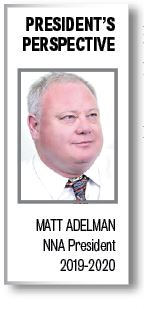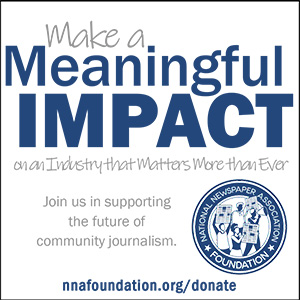Banding together to reach the peak of success
Al Cross
Special to Publishers' Auxiliary
Nov 1, 2019

MILWAUKEE, Wisconsin — Community newspaper publishers from all over the nation shared ideas for success at the NNA Leadership Summit that kicked off the association’s annual convention at The Pfister Hotel in Milwaukee Oct. 3.
The summit was held at a time when newspapers face much turmoil and “the greatest challenges ever,” said facilitator Marty Kaiser, who led the Milwaukee Journal Sentinel to three Pulitzer Prizes as editor and is a visiting fellow at the University of Maryland journalism school.
The theme of the summit was “How to make your newspaper an invaluable community asset,” and in doing so, sustain it financially.
It began with some lessons from the Poynter Institute’s “Table Stakes” program for local news innovation program in small markets, run by Cheryl Carpenter, who was a longtime editor for McClatchy Newspapers. It helps papers increase digital subscriptions, engage with their communities, and develop projects that turn their newsrooms into engines of revenue, by building reader loyalty.
“Keeping a customer is so much easier than losing one and trying to get one back,” Carpenter said. She added that the key is turning occasional readers “into habitual, valuable and paying loyalists.”
Carpenter said that as managing editor of the Charlotte Observer, “I thought I knew what made people start and end subscriptions,” but research showed that she didn’t. Lesson: “Be a little bit vulnerable in trying to figure out what you don’t know.”
She said newspapers need to ask themselves: “What do you need to learn about your audience? What audience do you want and don’t have? What is your power as a convener and community builder? How can you grow revenue from that?”
Some papers in “Table Stakes” have asked and answered those questions and are getting new revenue with newsletters, magazines, conferences, book clubs and events. “Their convening power was untapped,” she said of one paper that gleaned more than $100,000 from events in six months.
The program also helps with the transition to digital. Carpenter said one paper, before erecting a paywall, captured 16,000 email addresses in four months, helping it successfully market subscriptions.
Experimentation is essential, but so is testing and tracking of it, Carpenter advised.
And newspaper leaders need to personify the need to change. To get and keep their teams on board, she said: “You have to be as excited about it the 39th time you say it as the first time you say it.”
One paper that benefited from Table Stakes was the Lawrence Journal-World in Kansas. Its former publisher, Scott Stanford, now president and CEO of Fort Wayne Newspapers, said the key was getting reacquainted with the audience and aligning newsroom resources to match it.
“People didn’t read local editorials as much as we thought,” Stanford said. “People didn’t read high-school sports as much as we thought. More read city council stories than we thought.” Digital and print circulation grew, but “Everything takes longer than you think it will,” he said. “We thought we could accomplish in six months what it took us 18 months to do.”
Jeff Patterson, president of family–owned Adams Publishing Group, one of the most aggressive buyers of community papers in recent years, said the company’s drive to diversify revenue depends on hiring and keeping “the right people,” which means paying them more, with incentives. “Sometimes that means they make more money than the publisher.”
Patterson said salespeople also need the right tools, such as mobile technology to design ads on the spot, and the right incentives; the company measures performance not by revenue, but by “the number of proposals they write and how many appointments they make.”
Kaiser said research has shown that incentive pay works for news reporters, not just salespeople.
Jay Dickerson, advertising director of The Galena (Illinois) Gazette, a 5,000-circulation weekly, said it had found new revenue by being a graphics provider. “You’re probably the best design company in your community, he said. “These were opportunities that we didn’t think to tap.”
The summit broke up into roundtables that reported back to the whole group with their best ideas. Several dealt with local sports, an area where transient competitors often poach on local papers’ territory.
“All of us have had an issue with people coming in from out of town to sell sports posters and programs,” said Bill Tubbs of the North Scott Press in Eldridge, Iowa. He said his weekly partnered with sports boosters to produce a fall sports magazine that netted more than $15,000 and funneled a $2,000 gift to the school’s sports program, “and the people are happy ... It’s all about keeping the dollars in your community.”
Jeremy Waltner of the Freeman (South Dakota) Courier said the local homeschooled girls’ basketball team went to the state tournament, and the paper sold parents a $25 spot for a personalized message, printed exactly as submitted. “That’s an amazing community building thing,” Carpenter said.
Al Cross edited and managed rural newspapers before covering politics for the Louisville Courier Journal and serving as president of the Society of Professional Journalists. He is a journalism professor at the University of Kentucky and director of its Institute for Rural Journalism and Community Issues, which publishes The Rural Blog at http://irjci.blogspot.com.









